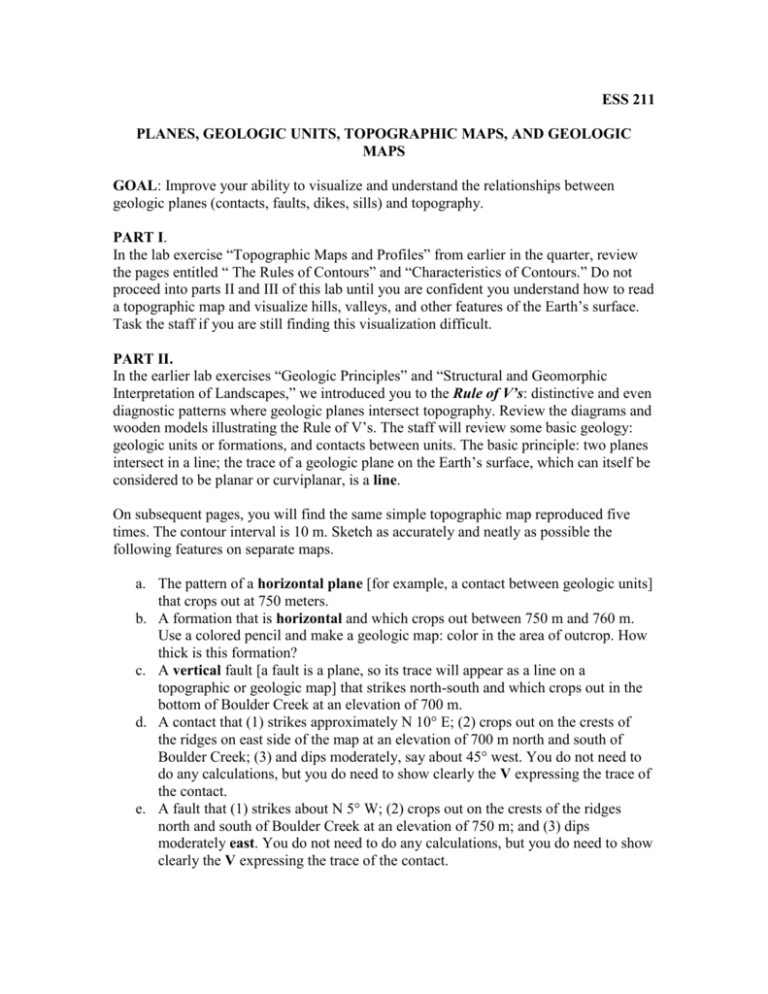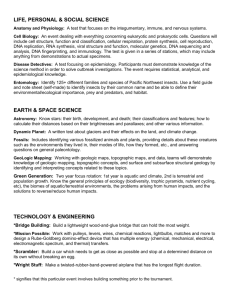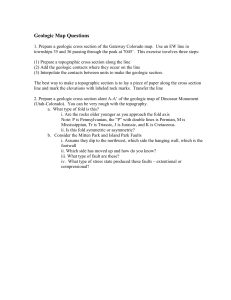Lab
advertisement

ESS 211 PLANES, GEOLOGIC UNITS, TOPOGRAPHIC MAPS, AND GEOLOGIC MAPS GOAL: Improve your ability to visualize and understand the relationships between geologic planes (contacts, faults, dikes, sills) and topography. PART I. In the lab exercise “Topographic Maps and Profiles” from earlier in the quarter, review the pages entitled “ The Rules of Contours” and “Characteristics of Contours.” Do not proceed into parts II and III of this lab until you are confident you understand how to read a topographic map and visualize hills, valleys, and other features of the Earth’s surface. Task the staff if you are still finding this visualization difficult. PART II. In the earlier lab exercises “Geologic Principles” and “Structural and Geomorphic Interpretation of Landscapes,” we introduced you to the Rule of V’s: distinctive and even diagnostic patterns where geologic planes intersect topography. Review the diagrams and wooden models illustrating the Rule of V’s. The staff will review some basic geology: geologic units or formations, and contacts between units. The basic principle: two planes intersect in a line; the trace of a geologic plane on the Earth’s surface, which can itself be considered to be planar or curviplanar, is a line. On subsequent pages, you will find the same simple topographic map reproduced five times. The contour interval is 10 m. Sketch as accurately and neatly as possible the following features on separate maps. a. The pattern of a horizontal plane [for example, a contact between geologic units] that crops out at 750 meters. b. A formation that is horizontal and which crops out between 750 m and 760 m. Use a colored pencil and make a geologic map: color in the area of outcrop. How thick is this formation? c. A vertical fault [a fault is a plane, so its trace will appear as a line on a topographic or geologic map] that strikes north-south and which crops out in the bottom of Boulder Creek at an elevation of 700 m. d. A contact that (1) strikes approximately N 10° E; (2) crops out on the crests of the ridges on east side of the map at an elevation of 700 m north and south of Boulder Creek; (3) and dips moderately, say about 45° west. You do not need to do any calculations, but you do need to show clearly the V expressing the trace of the contact. e. A fault that (1) strikes about N 5° W; (2) crops out on the crests of the ridges north and south of Boulder Creek at an elevation of 750 m; and (3) dips moderately east. You do not need to do any calculations, but you do need to show clearly the V expressing the trace of the contact. PART III. Now that you have reviewed familiarized yourself with the principles, you can apply your aptitude and skills to an actual published geologic map. On the course webpage [http://courses.washington.edu/ess211/Welcome.html] is a pdf of a geologic map: Geologic map of the Clarkston 15 minute quadrangle, Washington and Idaho [published by the State of Washington as GM-31]. You have already examined this map for an earlier lab exercise. The map sheet includes an explanation and a cross section. Familiarize yourself with the geologic units, the stratigraphy, and the symbols in the explanation. a. Find an example somewhere on the map (there are many!) where the geologic units are approximately horizontal. Provide the approximate coordinates [latitude and longitude] or the section [township, range, section] of your example. Most important, briefly state the criterion or criteria on which you based your selection. You may illustrate your criteria and selection with a simple colored sketch. b. Find an example of a vertical fault and describe its location. . Most important, briefly state the criterion or criteria on which you based your selection. You may illustrate your criteria and selection with a simple colored sketch. c. Navigate to the northern quarter of the map where units Tgr2 and Tgn1 crop out on the east-west striking slope north of the Snake River. Examine the contact between these geologic units and compare its trace on the southern edge of unit Tgn1 with its trace on the northern edge of unit Tgn1. Note that the attitude—the dip—of these units is expressed on the geologic map with conventional symbols for strike and dip, and you can also see the dips portrayed in the cross section. Using a few sentences, describe how the relationship of the contact and topographic contours accords with the Rule of V’s.






